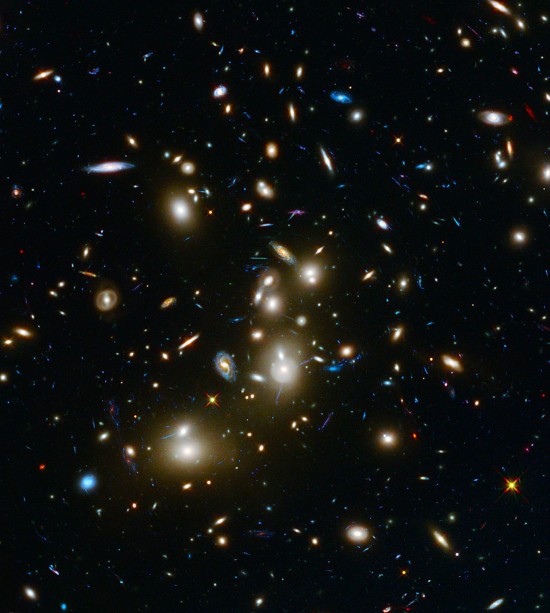
Galaxy cluster Abell 2744. Credit: NASA, ESA, and J. Lotz, M. Mountain, A. Koekemoer and the HFF Team (STScI)
Original Post August 13, 2014
Are colliding galaxies actually separating?
Astronomer Halton Arp discovered several relationships between various galaxies, and between galaxies and quasars, that led him to speculate that redshift is not an indicator of recessional speed or of distance to remote celestial objects.
Observations of those remote objects seem to contradict the consensus opinion among astronomers that the Universe is expanding. Quasars (and some galaxies) line up with the axes of low redshift galaxies. The objects with the highest redshifts near galactic nuclei are usually small with extreme redshifts; some moving at nearly 99% of light speed. Lower redshifted galaxies, inline with the small, fast objects, are considerably larger, with a billion times greater volume.
Around the strings of high redshift quasars are small galaxies accompanying the large ones, with slightly higher redshifts that are “quantized” at particular values. Often, chains of quasars and companion galaxies are contained within clouds of radio emitting, or X-ray emitting plasma.
Stars form along filaments of electric current that flow through, into, and out of galaxies. Studies of galactic magnetic fields show that the same process takes place to a greater or lesser extent in every galaxy. A recent Picture of the Day discussed another group of objects in association with the Milky Way: dwarf galaxies. It was noted that theories of galactic evolution suggest there should be far more of them than there actually are.
Another phenomenon that is difficult for conventional astronomers to explain is concentrations of stars in spherical orbits surrounding the nuclei of many galaxies. Globular clusters could be thought of as small-scale galactic nuclei, an idea that fits well with Arp’s observation that galactic nuclei eject core material that subsequently evolves into companion galaxies. Perhaps globular clusters are “seeds” flung out of galactic cores: “mini galaxies” born in the more dense star-forming regions of parent galaxies.
When “wandering stars” encounter another star with an electric field greater than their own, they can split into two smaller stars, so that the increased electrical stress will be distributed over a larger volume. If the electric current feeding an active star increases because more electric charge flows through the Birkeland current filament supplying the charge, that star might also split into a binary star system due to the increased amperage. Since more stars are binary systems (or greater), that could indicate the strength of the charge flow into the system.
Galaxies most likely behave in a similar fashion. Galaxies are part of clusters that, in turn, are part of superclusters. It is also apparent that galaxies occur in strings within the clusters. Since galaxies are also a manifestation of Birkeland currents creating Bennett pinches along their multi-million light-year lengths, it would be no surprise to find them splitting into two or more “daughter” galaxies in order to accommodate increases in their electric flux.
Perhaps what are conventionally interpreted to be galactic collisions are actually galaxies dividing. Since galaxies move so slowly, taking thousands or millions of years to change position, astronomers might be seeing the cart before the horse, and mistaking the direction of movement in their observations.
Stephen Smith












